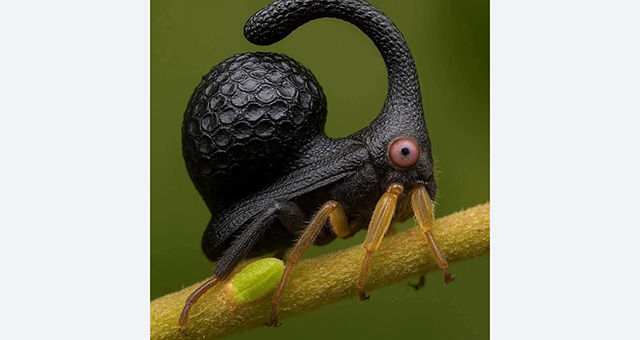Bocydium Trihopper: The Insect That Looks Like It Came from Outer Space
What Is It?
The Bocydium trihopper is a member of the Membracidae family, commonly referred to as treehoppers. Found mainly in the rainforests of South and Central America, this insect is famous for its bizarre and almost otherworldly appearance.
Its Unbelievable Appearance
What sets the trihopper apart from other insects is its highly unusual pronotum — an extended part of its thorax — which branches out into several globular or spherical structures on thin stalks. These strange helmet-like appendages don’t serve an obvious mechanical function like flying or feeding, but scientists believe they help deter predators by creating confusion or by mimicking something inedible or dangerous.
Its antennae are hook-shaped, adding to its alien look, and its overall body size is typically less than 1 centimeter — tiny, but unforgettable.
Evolution’s Strange Turn
The Bocydium is a perfect example of evolutionary extravagance. While most insects evolve to blend into their environments, the trihopper seems to do the opposite — stand out. But this might be exactly what protects it. When threatened, its silhouette may trick predators into thinking it’s something unpalatable, poisonous, or even artificial.
Some theories even suggest that its bulbous projections may vibrate or move slightly, adding to the illusion that it is something more than a soft-bodied insect.
Where Can You Find It?
These insects live primarily in the tropical forests of South America, where they attach themselves to tree branches and feed on plant sap. They are often difficult to spot due to their small size, but once you do — they’re unforgettable.
A Living Work of Art
While the Bocydium is not well-known outside of entomological circles, it has captured the imagination of artists, designers, and nature enthusiasts around the world. It’s frequently used as an example of how nature’s creativity rivals — and often surpasses — human imagination.
Quick Facts:
Scientific Name: Bocydium globulare
Family: Membracidae (Treehoppers)
Size: Less than 1 cm
Habitat: South American tropical forests
Defense: Confusing shape, possible mimicry
Diet: Plant sap
Sources:
Smithsonian National Museum of Natural History
BugGuide.Net — Membracidae taxonomy
Entomological Society of America Journal Archives
Peer-reviewed studies on insect mimicry and camouflage

